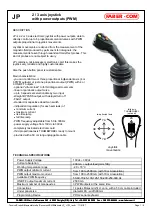
ProVU4 Controller, Profiler & Recorder/Controller - Product Manual
Page 152
Glossary
59407, Issue 3 – May 2011
PD Control
Proportional and Derivative (PD) control combines proportional control with derivative action.
It is similar to PID control, but without Integral action.
Also refer to: Derivative, Integral, PID Control, Proportional Control and Tuning.
PI Control
Proportional and Integral Control (PI) is most often used for modulating valve or motor
control. It combines proportional control with integral action. It is similar to PID Control, but
without derivative action that can cause excessive valve movement.
Also refer to: Derivative, Integral, Modulating Valve, PID Control, Proportional Control and
Tuning.
PID Control
Proportional Integral and Derivative control maintains accurate and stable levels in a process
(e.g. when controlling a temperature). Proportional Control avoids the oscillation
characteristic of On-Off control by continuously adjusting the correcting variable output(s) to
keep the process variable stable. Integral action eliminates control deviation errors, and
Derivative action counters rapid process movements.
Also refer to: Control Action, Control Deviation, Control Enable, Control Type, Controller,
Correcting Variable, Derivative Action, Integral Action, Manual Mode, On-Off Control, PD
Control, PI Control, Primary Proportional Band, Process Variable, Secondary Proportional
Band, Setpoint and Tuning.
PLC
This stands for Programmable Logic Controller. A microprocessor based device used in
machine control. It is particularly suited to sequential control applications, and uses “Ladder
Logic” programming techniques. Some PLC’s are capable of basic PID control, but tend to
be expensive and often give inferior levels of control.
Also refer to: PID.
Pre-Tune
The Pre-Tune facility artificially disturbs the start-up pattern so that a first approximation of
the PID values can be made prior to the setpoint being reached. During Pre-Tune, the
controller outputs full Primary Power until the process value has moved approximately
halfway to the setpoint. At that point, power is removed (or full Secondary Power is applied
for Dual Control), thereby introducing an oscillation. Once the oscillation peak has passed,
the Pre-Tune algorithm calculates an approximation of the optimum PID tuning terms
proportional band(s), integral and derivative. The Pre-Tune process is shown in the diagram
on the next page.
















































